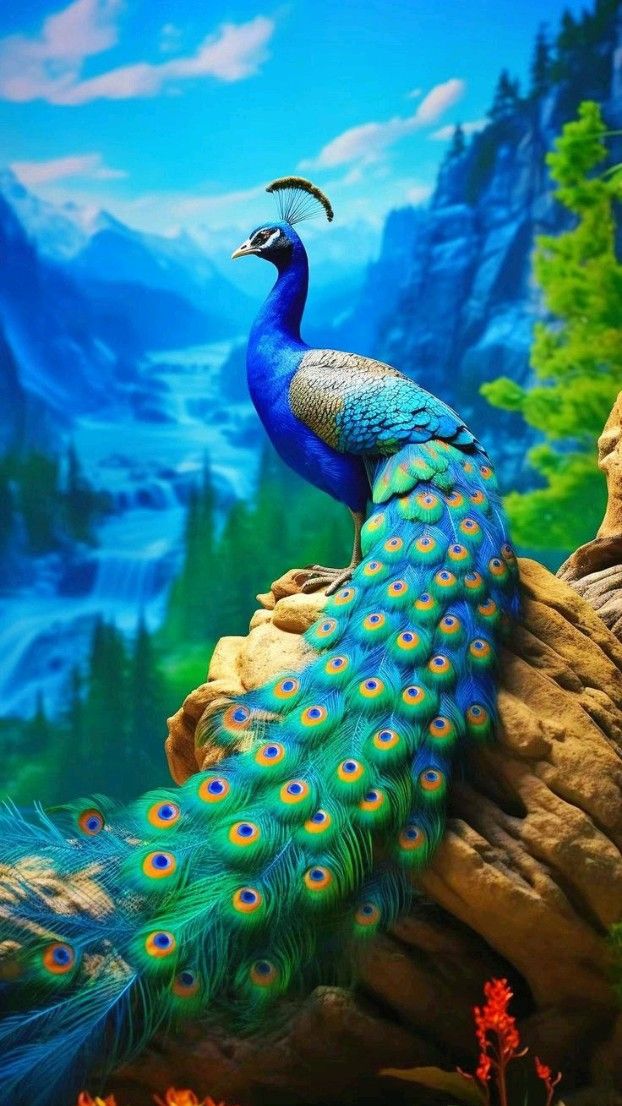7 Fascinating Facts About the National Bird of India – The Majestic Peacock!
National Bird of India: India, a land of rich heritage and culture, boasts many national symbols that reflect its traditions and natural wealth. Among them, the Indian Peacock (Pavo cristatus) stands out as the National Bird of India. This stunning bird is a symbol of beauty, grace, and pride. Its vibrant plumage, mesmerizing dance, and cultural significance make it an integral part of India’s identity.
In this article, we will explore everything about the Indian Peacock – its history, significance, impact on daily life, interesting facts, FAQs, and its role in society.
All About the National Bird of India – The Indian Peacock
The Indian Peacock, commonly known as the peafowl, is a breathtaking bird found in forests, grasslands, and even urban areas of India. The male, called the peacock, is famous for its iridescent blue-green plumage and long, elaborate tail feathers, which it fans out during courtship displays. The female, known as the peahen, has a more subdued appearance but plays an equally important role in nature.
Scientific Classification
- Scientific Name: Pavo cristatus
- Family: Phasianidae
- Order: Galliformes
- Habitat: Forests, grasslands, agricultural fields, and urban areas
- Diet: Omnivorous – feeds on seeds, insects, small reptiles, and grains
Why is the Peacock the National Bird of India?
The Indian Peacock was declared the National Bird of India in 1963 due to its cultural and religious significance, as well as its striking beauty. It was chosen over other birds because:
- It is widely found across India – from forests to villages.
- It is associated with Hindu mythology and religious beliefs.
- Its vibrant colors and majestic appearance symbolize India’s rich culture.
- It plays an essential role in the ecosystem by controlling insect populations.
- It has been a part of Indian art, poetry, and folklore for centuries.
History & Cultural Significance
The peacock has held a special place in Indian history and mythology for thousands of years:
- In Hinduism, the peacock is the vahana (vehicle) of Lord Kartikeya, the God of War. It is also associated with Goddess Saraswati, symbolizing wisdom and learning.
- In Buddhism, peacocks represent purity and enlightenment, as they are believed to consume poisonous plants but remain unaffected.
- In Mughal history, Emperor Shah Jahan built the famous Peacock Throne, adorned with jewels, symbolizing royalty and prosperity.
- In Indian folklore and poetry, the peacock is often linked to monsoons, romance, and divine beauty.
Impact of the Peacock on Daily Life
The peacock is not just a bird of admiration; it plays a role in various aspects of daily life in India:
1. Environmental Balance
Peacocks help maintain the ecosystem by controlling pests and insects, thus benefiting farmers and gardeners.
2. Cultural Influence
From traditional paintings to modern fashion, the peacock’s feathers, colors, and motifs inspire designs in textiles, jewelry, and decorations.
3. Religious Rituals & Celebrations
Peacock feathers are often used in temples, rituals, and festivals, especially during Krishna Janmashtami and other Hindu celebrations.
4. Tourism & Conservation
Peacocks attract bird watchers, photographers, and tourists, boosting wildlife tourism in national parks and sanctuaries.
5. Symbol of Pride & Patriotism
The peacock is featured in official government emblems, postage stamps, and cultural performances, representing India’s pride and national identity.
7 Interesting Facts About the Indian Peacock
- Peacocks can dance in the rain – Their elegant dance during the monsoon season is believed to bring good luck and prosperity.
- They can grow up to 7 feet in length, making them one of the largest flying birds in the world.
- Peacocks don’t have blue pigments – Their feathers appear blue due to the phenomenon of structural coloration.
- They shed their feathers naturally – Peacock feathers are often used in decorations and religious rituals without harming the bird.
- A group of peacocks is called a “muster.”
- Peafowls are known for their loud calls, which they use to communicate and warn others of danger.
- The peacock is protected under the Indian Wildlife Protection Act, 1972, making it illegal to hunt or harm them.
Significance of the National Bird in Society
The peacock is more than just a symbol of beauty – it represents:
✅ Pride & Grace – Like the peacock, India stands tall with cultural richness and dignity.
✅ Harmony & Peace – The peacock’s peaceful nature signifies unity and coexistence.
✅ Strength & Protection – In mythology, the peacock fights snakes and evildoers, symbolizing victory over darkness.
Observance & Conservation Efforts
Despite being protected, peacocks face threats from:
❌ Habitat destruction
❌ Illegal poaching
❌ Pesticides affecting their food sources
To conserve India’s national bird, efforts include:
✔ Wildlife Protection Laws to prevent hunting and illegal trading.
✔ Peacock Conservation Projects in various states.
✔ Educating locals about their importance in the ecosystem.
FAQs About the National Bird of India
1. Why was the peacock chosen as the national bird of India?
It was chosen for its beauty, widespread presence, cultural importance, and role in Indian traditions.
2. Is it legal to keep peacocks as pets in India?
No, peacocks are protected under the Wildlife Protection Act, 1972, and keeping them as pets is illegal.
3. What do peacocks eat?
They are omnivores, feeding on grains, seeds, insects, small reptiles, and even flowers.
4. Do peacocks bring good luck?
Yes, in many cultures, peacocks symbolize prosperity, wisdom, and protection from evil.
5. How long do peacocks live?
Peacocks can live up to 15–20 years in the wild and even longer in protected areas.
Wishing Someone on National Bird Day or Wildlife Awareness Events
🌿 “May the grace and beauty of India’s national bird inspire us to protect nature. Happy Wildlife Conservation Day!”
🦚 “Like the peacock’s dance, let’s celebrate the richness of Indian heritage and its majestic wildlife!”
Final Thoughts: National Bird of India
The Indian Peacock is not just a bird; it’s a symbol of India’s pride, culture, and environmental beauty. As the National Bird of India, it plays a vital role in nature and society. By protecting peacocks and their habitats, we help preserve India’s biodiversity and heritage for future generations.
Would you like to read more about India’s national symbols? Drop a comment and share your thoughts! 💬🦚










